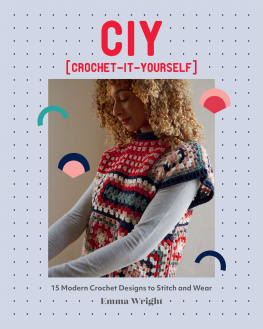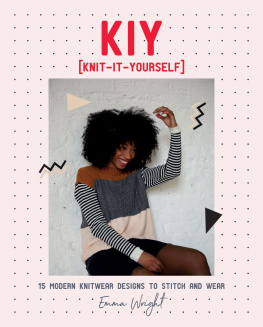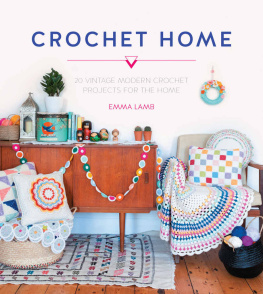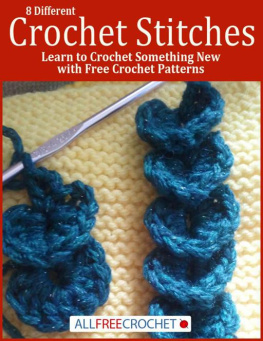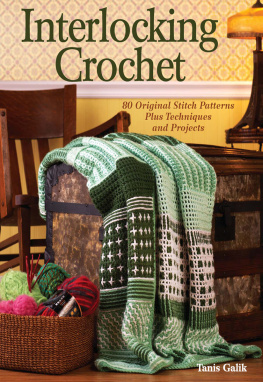


I taught myself to crochet in the six weeks of holiday between my first and second years of college, after falling back in love with hand knitting. I spent hour after hour looking through old crochet books and delving deep into the thousands of online tutorials. After graduating in fashion knitwear and knitted textiles, I knew crochet would play an important role in my career. My first ever make was a simple bunny for my younger sister, followed by anything I could make out of a granny square: purses, hats and even dresses. Ive since worked with many yarn brands and magazines to create modern but timeless crochet collections.
For me, crochet allows you a freedom that no other craft can. You can build and craft your fabric in any direction, keeping things classic or going freeform to create something artistic and three-dimensional. Theres something so satisfying and soothing about the repetition of creating each individual stitch with just a hook and ball of yarn; the possibilities are endless. Im a strong believer that every pattern is just a guide and its what you add to that guide that makes that project personal, what makes it your own. That may begin with your yarn choicethe fiber, color or texturefollowed by your choice of stitch, placement, color blocking or adding other elements such as zippers or embroidery. All these things bring personality and individuality to your projects, making them one of a kind.
Something I was keen to feature to this book was accessories; I wanted to include the classics such as a beanie hat, heeled socks, a chunky scarf and a backpack. I find designing accessories so much funyou can easily add your own personality through color placement, construction or even through embroidery. I often get carried away swatching for accessories and, before I know it, I have the finished piece. After swatching, I use my final gauge (tension) for that design to calculate all the measurements I need for the finished sweater, cardigan or accessory. I then write the pattern and send it out to one of the lovely ladies who make them up for meor if Im lucky I might be able to make it up myself, depending on my other workload.
The garment projects in this book are classic, timeless and staple pieces to add to your repertoire. My hope for these projects is that, as well as introducing you to some new and practical techniques, they will also bring longevity to the pieces in your wardrobe. Having a classic sweater, cardiganor even bothis a must for a capsule wardrobe and I hope you enjoy using my book to help you achieve both a CIY collection whilst perfecting some new techniques along the way!
Welcome to my crochet workshop: my aim for this book is to help you advance your crochet skills. Im assuming you already know how to crochet and already have a couple of projects under your belt; there is no better way to learn than to Crochet It Yourself. This book is split into three sectionsSweaters, Cardigans and Accessorieswith each pattern containing its own CIY technique for you to master. Each pattern comes with helpful hints and tips and there are for you to draw out your own design ideas.
Design Process
Although I love craft, in any form, I like my designs to have a polished and modern finish. There is something so satisfying about creating those refined details by hand or hook. This is important to me when designing a new piece and often where my design process begins. Im also an avid Pinterest scroller and create a new board for every new project I begin. You could also create a photo album on your phone, full of images youve taken from shopping on the high street, from magazines, books or catalogs, of flowers, architecture or art that makes you feel inspired. This can help with decisions on finishing, color choices and even what yarn you decide to use.
Using Color
When designing I often start with color. Working with color can be approached in many different waysif you love it then why not wear it? You can find color inspiration and color trends anywhere; you can take inspiration from fashion, nature, art, photography. I enjoy going out for a walk and taking photos of surrounding landscapes and flowers for my color inspiration. I often add these images to my project mood boards. Beginning with primary colors is a great place to start, then introduce secondary and tertiary color to create your palette.
Working with complementary colors or following color trends can also give you a starting point. I like to start with a base color, something neutral such as white, cream, beige or blackand personally I would also class gray and navy as a base or background color. The mood of your palette will change depending on your base color; white will give you a fresher look, compared to black or gray, which will create a much moodier tone. Another great tip for creating a harmonious color palette is to work in odd numbers, so pick a palette of three, five or seven colors, especially if you are using this palette for color work.
Swatching
Once you have your inspiration and have put your mood board togetherwhether thats using paper and glue or digitallyits time to start swatching. This is my favorite part of design; its time to visit your bricks-and-mortar store, squish some yarn, pick up your favorite hook and get crocheting! Swatching is so important; although many find this part of starting a new project tedious, its super important to get your gauge (tension) to match that given in the pattern otherwise the fit and size of your project may be incorrect. Its important to adjust your hook size to obtain the correct tension given in the pattern: if your swatch works up too big using the hook size in the pattern try a smaller hook, or if it is too small switch to a larger one. This way the finished fabric wont become too tight or loose.


Project Construction
Making up your project can be done in many ways. You can keep it simple and use running or back stitch, make things a little neater with mattress stitch or even crochet your work together using slip stitch or single crochet stitch. Crocheting your work together is quick and can be beneficial if you want a sturdy seam, when constructing accessories such as a backpack or a clutch purse. Coming from a pattern-cutting background I believe seams are there for a reason; we need them to help shape a garment or accessory and the type of sewing up we choose can play a big part in how that finished piece looks. I like to block each garment/accessory panel before and after construction. Blocking each piece before sewing can make construction easier and blocking after will help flatten out and soften each seam.
Aftercare
When you have invested time and money into your crochet you will want to make sure you look after it well. My advice would be to wash the items as few times as you can. I like to air my pieces outside on the washing line to freshen them up and make it possible to go longer between washing. If, however, you do need to launder them always follow the washing instructions from the ball band of the yarn youve usedits a good idea to take a photo of these instructions on your phone or tablet. Its usually best to hand wash your crochet and keep light and dark colors separate. Use warm water and mix it with a gentle detergent. Submerge the garment or accessory and soak it for 1015 minutes. Carefully rinse in warm water, then press out or squeeze to remove as much water as possible. Place flat on a dry towel, pulling it gently back into shape if necessary. Keep it away from sunlight and let it air dry at room temperature. Make sure the item is completely dry before putting it away. To store your crochet between wearing its best to fold garments flat and not hang them; this avoids them stretching out of shape.
Next page
